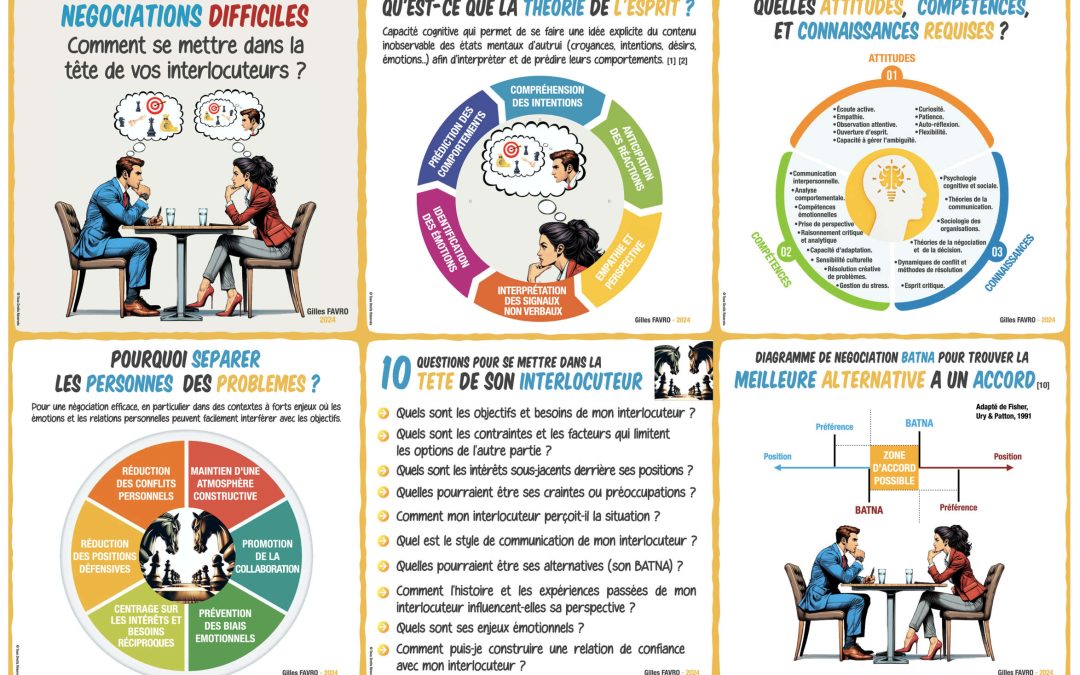La négociation est un processus de communication et d’ajustement entre deux ou plusieurs parties en vue de résoudre des points de divergence. C’est pourquoi il est important de savoir comment aborder efficacement une négociation afin de parvenir à des accords équitables et mutuellement bénéfiques.
Dans ce contexte :
- Comment anticiper les besoins, les intentions et les réactions de l’autre partie ?
- Comment identifier et comprendre ses préoccupations et ses motivations ?
- Quelles attitudes, compétences et connaissances développer ?
- Quelles questions se poser ?
- De quelle manière identifier des solutions gagnant-gagnant ?
Je me propose de répondre à ces questions dans ce PDF à télécharger.
✍ Si la mise en œuvre de solutions pérennes et durables est un enjeu pour vous ou pour vos équipes, n’hésitez pas à m’écrire.
Chaque semaine, je vous apporte de robustes connaissances issues des sciences cognitives, science comportementale contextuelle, sciences affectives, et de la sociologie des organisations, pour vous aider à mieux comprendre les comportements humains au travail.
Références :
[1] Baron-Cohen, S. (1991). Precursors to a theory of mind: understanding attention in others in Natural theories of mind: Evolution, development and simulation of everyday mindreading. ed. A. Whiten (Cambridge, MA: Basil Blackwell), 233–251.
[2] Arslan, B., Hohenberger, A., &Verbrugge, R.( 2012). The development of second-order social cognition and its relation with complex language understanding and memory. In Proceedings of the 34th annual conference of the cognitive science society (pp. 1290–1295).
[3] Thompson, L. (2012). The Mind and Heart of the Negotiator. (5th ed.) Pearson Education.
[4] Bazerman, M. H., and M. A. Neale. Negotiating Rationally. Free Press, 1992
[5] Galinsky, Maddux, Gilin, White (2008) Why It Pays to Get Inside the Head of Your Opponent, Psych Science
[6] Oswald, P.A. (1996). The effects of cognitive and affective perspective- taking on empathic concern and altruistic helping. The Journal of Social Psychology, 136, 613–623.
[7] Scherer, K. R. (2009b). The dynamic architecture of emotion: Evidence for the component process model. Cognition & Emotion, 23, 1307–1351.
[8] Byom, L. J., & Mutlu, B. (2013). Theory of mind: Mechanisms, methods, and new directions. Frontiers in Human Neuroscience, 7,
[9] Bornemann, B., and Christen, M. (2020). Navigating between complexity and control in transdisciplinary problem framing: meaning making as an approach to reflexive integration. Soc. Epistemol. 34, 357–369. doi: 10.1080/02691728.2019.1706120
[10] Fisher,R.,&Ury,W.L (1981). Getting to yes: Negotiating agreement without giving in. London : Penguin Group.
[11] Carneiro, D., Novais, P., Andrade, F., Zeleznikow, J., and Neves, J. (2012). Using case-based reasoning and principled negotiation to provide decision support for dispute resolution. Knowl. Inf. Syst. 36, 789–826. doi: 10.1007/s10115-012-0563-0
RESPIRE un livre où vous trouverez sans doute une réponse à une question. Laquelle ?


